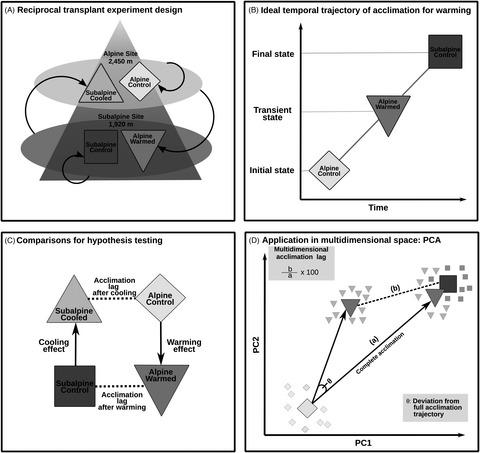Our official English website, www.x-mol.net, welcomes your feedback! (Note: you will need to create a separate account there.)
Lags in phenological acclimation of mountain grasslands after recent warming
Journal of Ecology ( IF 5.5 ) Pub Date : 2021-06-11 , DOI: 10.1111/1365-2745.13727 Billur Bektaş 1 , Wilfried Thuiller 1 , Amelie Saillard 1 , Philippe Choler 1 , Julien Renaud 1 , Marie‐Pascale Colace 1 , Raphael Della Vedova 2 , Tamara Münkemüller 1
中文翻译:

近期变暖后山地草原物候驯化滞后
更新日期:2021-06-11
Journal of Ecology ( IF 5.5 ) Pub Date : 2021-06-11 , DOI: 10.1111/1365-2745.13727 Billur Bektaş 1 , Wilfried Thuiller 1 , Amelie Saillard 1 , Philippe Choler 1 , Julien Renaud 1 , Marie‐Pascale Colace 1 , Raphael Della Vedova 2 , Tamara Münkemüller 1
Affiliation

|
- In the current biodiversity crisis, one of the crucial questions is how quickly plant communities can acclimate to climate warming and longer growing seasons to buffer the impairment of community functioning. Answering this question is pivotal especially for mountain grasslands that experience harsh conditions but provide essential ecosystem services to people.
- We conducted a reciprocal transplant experiment along an elevation gradient (1,920 m vs. 2,450 m) in the French Alps to test the ability of plant species and communities to acclimate to warming and cooling. For 3 years, we measured weekly the timing of phenological events (e.g. start of flowering or greening) and the length of phenological stages linked to demographic performance (e.g. lengths of flowering or greening periods).
- We found that warming (and cooling) changed the timing of phenological events strongly enough to result in complete acclimation for graminoids, for communities in early and mid-season, but not at all for forbs. For example, warming resulted in later greening of communities and delayed all phenophases of graminoids. Lengths of phenological stages did not respond strongly enough to climate change to acclimate completely, except for graminoids. For example, warming led to an acclimation lag in the community's yearly productivity and had a strong negative impact on flowering of forbs. Overall, when there was an acclimation failure, responses to cooling were mostly symmetric and confirmed slow acclimation in mountain grasslands.
- Synthesis. Our study highlights that phenological plasticity cannot prevent disruption of community functioning under climate warming in the short term. The failures to acclimate after 3 years of warming signals that species and communities underperform and are probably at high risk of being replaced by locally better-adapted plants.
中文翻译:

近期变暖后山地草原物候驯化滞后
- 在当前的生物多样性危机中,关键问题之一是植物群落能够以多快的速度适应气候变暖和更长的生长季节,以缓冲对群落功能的损害。回答这个问题至关重要,特别是对于条件恶劣但为人们提供基本生态系统服务的山地草原。
- 我们在法国阿尔卑斯山沿海拔梯度(1,920 m 与 2,450 m)进行了相互移植实验,以测试植物物种和群落适应变暖和变冷的能力。3 年来,我们每周测量物候事件的时间(例如开花或绿化的开始)和与人口表现相关的物候阶段的长度(例如开花或绿化期的长度)。
- 我们发现变暖(和变冷)强烈地改变了物候事件的时间,足以导致禾本科植物、季节早期和中期的社区完全适应,但对于杂种植物则完全没有。例如,变暖导致社区后期绿化并延迟了禾本科植物的所有物候期。物候阶段的长度对气候变化的反应不够强烈,无法完全适应,除了禾本科。例如,变暖导致社区年生产力的适应滞后,并对杂草开花产生强烈的负面影响。总体而言,当驯化失败时,对冷却的反应大多是对称的,并证实了山地草原的缓慢驯化。
- 合成。我们的研究强调,短期内物候可塑性无法防止气候变暖对社区功能的破坏。气候变暖 3 年后未能适应环境表明物种和群落表现不佳,很可能被当地适应性更好的植物所取代。



























 京公网安备 11010802027423号
京公网安备 11010802027423号